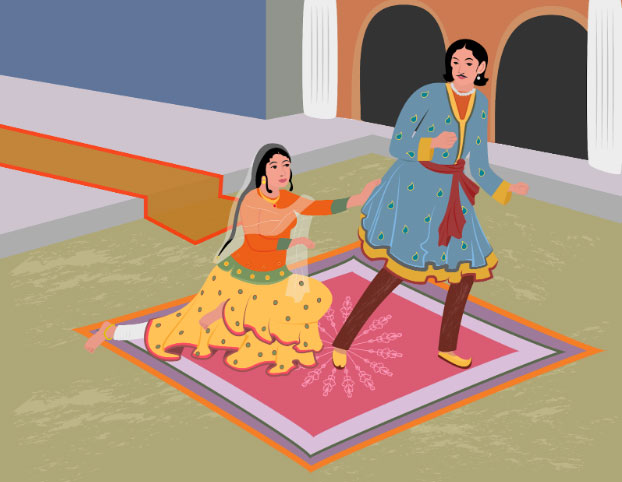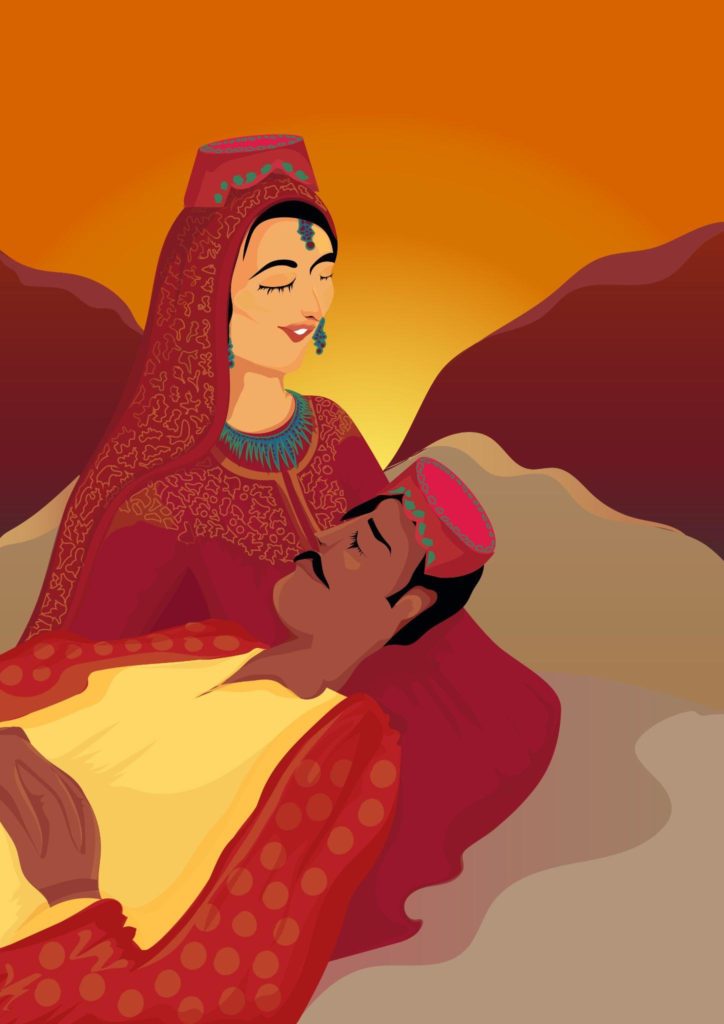Sindhu
Grantee Profile
Faiza Junejo
Faiza Junejo graduated in Communication Design with a distinction from Center of Excellence in Arts and Design (CEAD), Mehran University, Jamshoro in 2017. Currently she is working as a Lecturer at SABS University Jamshoro. Junejo has previously worked in the field of advertising and serves as mentor at Nishat Welfare Organization, Hyderabad.
Project
Tourism is one of the world’s fastest growing industries and a major source of foreign exchange and employment in many countries. It is now a dynamic sector of external economic growth in many countries across the world. The growth of tourism has the potential to contribute to the economic and social development of the country as a whole along with the inflow of significant volumes of foreign currency, infrastructural development, and introduction of economic reforms. Most of the developed European countries, such as France, Austria, and Switzerland have improved their social and economic reforms on profits from tourism. Many developing economies view tourism as a powerful source of foreign exchange and a means to balance foreign trade and industry without any manufacturing process.
Tourism in Pakistan is increasing. According to a report published by World Travel and Tourism Council, 2021, tourism’s contribution to Pakistan’s GDP has increased from 2.9% ($8.8 Billion) in 2017 to 5.7% ($15 Billion) in 2019. During covid the contribution fell to 4.4% of the GDP in 2020. Likewise jobs in tourism “11.1% from 3.45 million in 2019 to 3.63 million in 2020.” It is also noteworthy that of the total tourists, 91% are local tourists.
This research acknowledges the potential of tourism in Sind, Pakistan, while exploring performing arts as a contributor to the fledgling industry. Drawing upon the rich cultural heritage of Sind, it proposes an integration of both in order to create more fulfilling experiences for tourists while at the same time creating opportunities for livelihood for the local performers and local population as well as a source of revenue for the province.
Research Background
Today’s travelers as consumers have reached a stage that goes beyond tourism in which their travel motivation is not about wanting to experience an idealized version of a foreign culture but rather to become exposed and immersed in the native country’s language, art, cultural heritage and patterns of life (Teo, Khan, & Abd Rahim, 2014). Performing arts are very effective tools for communicating an area’s culture and history to tourists through its traditional music and dance or ritual. As when tourists watch the traditional performing arts, they come to know the history, culture and customs of the people living in that area (Io, M.-U. 2019).
Performing arts attract tourism and the economy benefits significantly from the performing arts. To the world of tourism, art brings “style, culture, beauty, and a sense of continuity of living”(Jang, 2012). Tourist attractions and performing arts projects are the most basic ways for tourists to experience scenic facilities, local cultural connotations and folk customs, (Zhang, 2017). Performing arts projects integrated with tourist attractions are comprehensive display projects which combine various means with the local folk customs, cultural resources and cultural performances.
Outstanding performing arts projects can improve tourist’s interests and become the publicizing signboard of scenic spots, encouraging tourism and related industries to improve quality and efficiency (Zhang, 2017). Moreover, Rodzi, Zaki, and Subli (2013) examined the positive and negative views of past studies about tourism and cultural heritage. They found that tourists are more attracted to cultural heritage sites compared to other tourist’s spots, and cultural tourism is reported highest in influencing tourist satisfaction. Hence, numerous performance planners, directors and producers around the world expect this investment to grow (Park & Petrick, 2016).
However, unfortunately, cultural tourism has been given less attention for decades particularly in the context of Pakistan (Olalere, 2019). Its cultural tourism resources are not promoted to the extent to which it becomes a significant part of the nation’s destination image. Lack of promotion and information available makes international visitors unaware about the potential of Pakistan as a cultural tourism destination (Sudipta & Sarat, 2010). Hence, this project proposal is a foundational step towards integrating the rich cultural heritage of performing arts with tourism which will lead to the enhancement of prospects of the overall tourism business in Sindh, Pakistan.
Performing arts are an aspect of culture of any society, such as plays, operas, music, dance, and musicals can promote the culture of a country, its historical legacy, the artistic talents of performers, and/or creative ideas (Kim, Chung, Petrick, & Park, 2018). On the other hand tourism involves traveling from one destination to another by a person or group of persons for the purpose of leisure, social interaction and trade (Bell-Gam, 2009). Although performing arts and tourism can exist and function in isolation, a close link in their operations can have fruitful results. As Park and Petrick (2016) claim that performing arts tourism products are cultural products that offer happiness and pleasure in one’s life by providing emotional excitement.
Sudipta and Sarat (2010) looked into the area of cultural tourism in Pakistan and how it is viewed by international tourists from India. The study revealed that Pakistan’s cultural tourism resources are not promoted to the extent to which it becomes a significant part of the nation’s destination image. Lack of promotion and information available makes local and international visitors unaware about the potential of Pakistan as a cultural tourism destination.
Furthermore, (Bakari, 2013) examined the link between the performing arts and tourism in Tanzania and assessed the extent to which the performing arts promote the tourism industry in Tanzania. The study examined The Bagamoyo Festival of Arts and Culture and The Mtwara’s Makuya Festival. It adopted a primary data collection approach using questionnaire and interview instruments targeted at different stakeholders including tourists, tour operators and performing artists. The results showed that performing arts could be used to promote tourism in their own right as well as promoting nature tourism attractions. However, challenges include inadequate skills on how to produce and market performing arts for touristic audiences and an absence of a collaboration model between performing arts and tourism sectors.
Olalere (2019) states in the context of Malaysia that culture can only be revitalized and sustained when the owning community considers the cultural tradition to be of significant importance. Zheng, Ritchie, Benckendorff, and Bao (2019) identified the causes and consequences of resident emotions toward Tourism Performing Arts developments across urban and rural communities. Results revealed that rural residents reported a higher intensity of positive emotions and were more supportive towards Tourism Performing Arts development. Findings also suggested targeted strategies such as promoting Tourism Performing Arts in urban communities and offering preferential local access for rural communities.
The name of the project comes from Sindhu Darya (Sindhu River) better known as the River Indus. Sindhu is a project proposal that integrates Performing Arts with tourism. Drawing upon stories of the seven female characters recorded in Shah jo Risalo, a compilation of poetry of Shah Abdul Latif Bhitai, the proposal suggests a tour of Sindh including the sites which are said to be the setting for the stories. This information is compiled in the form of an animated map accessible for tourists and audiences. The researcher also decided to include the story of (Sorath Rai Diyach) set in Gujrat, India as it also forms part of the cultural heritage of Sindh. The tour culminates in a performing arts festival which features musical and theatrical performances of the stories. These stories are part of the cultural heritage of Sindh as they continue to be communicated via Waai’s performances at the shrine of Shah Abdul Latif Bhittai, in Bhit Shah, Sindh and popular songs by contemporary performers. Some have even been dramatized and telecasted via PTV. One aspect of the project focuses on the challenge of development of a visual identity for Sindhu, informing potential tourists about the rich cultural heritage of Sindh its promotion to a wider audience. While the other aspect proposes a way forward for increasing tourism in Pakistan, by bringing the performers and tourism industry together to improve the experience for the tourists while also widening the scope for performing arts and building a soft image for Pakistan.

Visual Map charting the route of the tour and depicting the areas the stories are ascribed to.

Flyer with QR code scanner of animated map

Story of Leela Chanesar – ascribed to Kutch, now called District Thatta, Sindh, Pakistan

Story of Sorath Rai Diyach – ascribed to Grinar, Junagadh in Gujarat, India

Story of Noori Jam Tamachi – ascribed to Keenjhar Lake, Thatta, Sindh, Pakistan

Sohni Mehar ascribed to Shahdadpur town Sanghar District, Sindh, Pakistan

Umar Marvi – ascribed to Umerkot and Malir (Thar) Sindh, Pakistan

Moomal Rano, ascribed to Ghotki, Sindh, Pakistan

Sassui Punhu ascribed to Lasbela, Balochistan, Pakistan
Illustrators – Ria Ramesh, Pooja Karman, Deenar Hafeez, Areeba Gul, Rubaisha Memon, Shuja Muhamma, Farwa Ali, Bakhtawar Surani, Areeda Nasir
Animators – Najeeb Rashdi and Yasir Baloch
References
Ary, D., Jacobs, L. C., Sorensen, C. K., & Walker, D. (2013). Introduction to research in education: Cengage Learning.
Bakari, J. A. (2013). Performing Arts and Promotion of Tourism in Tanzania: A Study of The Bagamoyo and the Makuya Arts Festivals. The Open University of Tanzania.
Bell-Gam, H. L. (2009). Strategies for the development of tourism and theatre industries in Nigeria: Rivers state perspective. Creative Artist: A Journal of Theatre and Media Studies, 3(1).
Io, M.-U. (2019). Understanding the core attractiveness of performing arts heritage to international tourists. Tourism Geographies, 21(4), 687-705.
Jang, S. H. (2012). The Korean Wave and its implications for the Korea-China relationship. Journal of International and Area Studies, 97-113.
Kim, S., Chung, J. Y., Petrick, J., & Park, J. W. (2018). Determination of preferred performing arts tourism products using conjoint analysis. Journal of Vacation Marketing, 24(1), 44-61.
Olalere, F. E. (2019). Intangible Cultural Heritage as Tourism Product: The Malaysia Experience. Intangible Cultural Heritage as Tourism Product: The Malaysia Experience, 8(3).
Park, C., & Petrick, J. F. (2016). Developing the optimal Korean performing arts tourism product for Japanese tourists.
Rodzi, N. I. M., Zaki, S. A., & Subli, S. M. H. S. (2013). Between tourism and intangible cultural heritage. Procedia-Social and Behavioral Sciences, 85, 411-420.
Smith, M. K. (2009). Issues in cultural tourism studies: Routledge.
Sudipta, K. S., & Sarat, L. (2010). Cultural tourism in Malaysia in the perspective of Indian tourists: A study. Revista de turism studii și cercetări în turism(10), 48-53.
Teo, C. B. C., Khan, N. R. M., & Abd Rahim, F. H. (2014). Understanding cultural heritage visitor behavior: the case of Melaka as a world heritage city. Procedia-Social and Behavioral Sciences, 130, 1-10.
Toon, E., & Chiat, L. F. (2015). An Observation on Three Local Bilingual Musicals in Malaysia. Music: Ethics and the Community, 341-352.
Zhang, Y. (2017). An Empirical Study on the Experience Satisfaction of Tourism Performing Arts Project under the Experience Economic Background–Taking Heyuan City as an Example. Paper presented at the 2017 International Conference on Economics, Finance and Statistics (ICEFS 2017).
Zheng, D., Ritchie, B. W., Benckendorff, P. J., & Bao, J. (2019). Emotional responses toward Tourism Performing Arts Development: A comparison of urban and rural residents in China. Tourism Management, 70, 238-249.